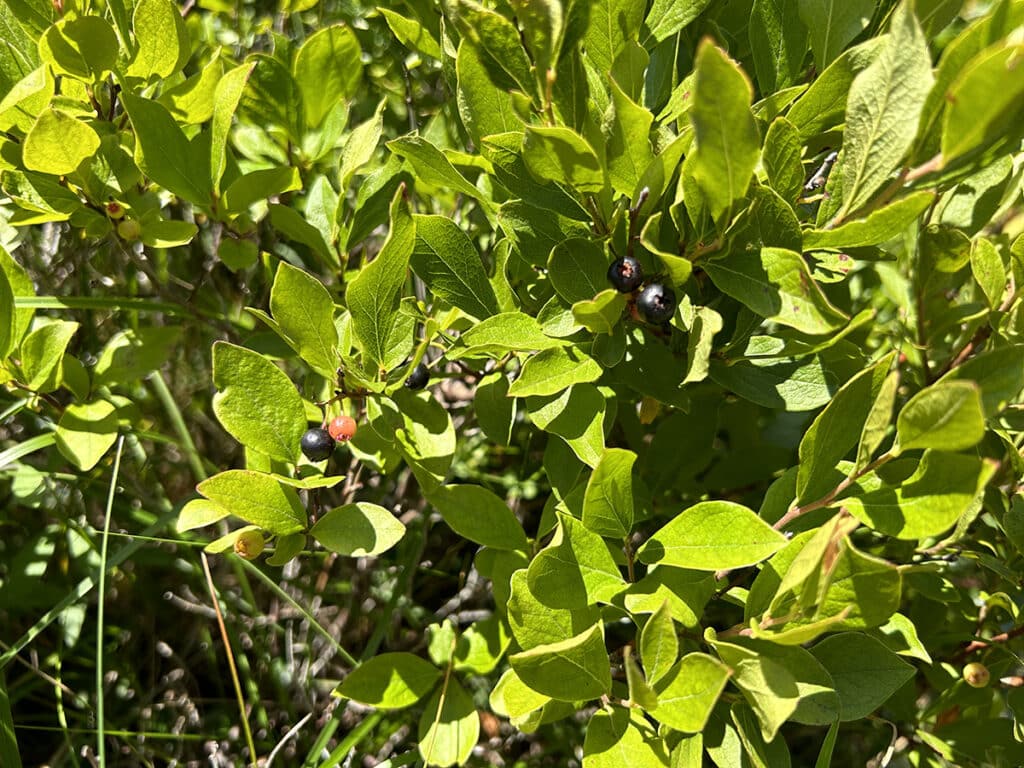by Dr. Sarah Treanor Bois, PhD
Director of Research & Education at the Linda Loring Nature Foundation
If you’ve ever seen the 1993 movie Tombstone, you’ve heard the iconic line, “I’m your huckleberry” that Doc Holiday says to Wyatt Earp. It’s a way of saying that he’s just the right person for the job. So, when it comes to eating wild huckleberries? Well, “I’m your…” you get the idea.
I am spoilt this time of year working in the field or out on the trails. Late July into August is when the berries are at their peak, and I can easily find a snack while out in the hot summer sun. The blueberries (both highbush and lowbush) are bountiful around the island, but are waning in their abundance as they are picked by people and eaten by wildlife. Their season is over. Anyway, I tend to favor their cousin, the delightful black huckleberry.

Black huckleberries deserve more recognition for being so amazing. However, it’s the earlier fruiting blueberries that capture all the attention. Maybe it’s because blueberries are something recognizable, something people see in the grocery store. Or maybe its popularity is because you can pick them by the pound. Either way, both are delicious, but I think huckleberries edge out blueberries in the flavor department.
Huckleberries and blueberries are all part of the Ericaceae plant family, the heather family. These ericaceous shrubs also include Azaleas, Bearberries, Blueberries, Cranberries, Heathers, and Rhododendrons. These plants love acidic soils typically having a pH between 4.5 and 6. It’s a wonder anything can grow in our nutrient poor, sandy, acidic conditions, and these heathland shrubs thrive here.
On Nantucket, our huckleberries are the species Gaylussacia baccata. But that’s the problem with common names. We often use the same name to mean different things. In North America, the name “huckleberry” has been applied to numerous plant variations, all bearing small berries with colors that may be red, blue, or black. It is the common name for various Gaylussacia species, and some Vaccinium species, such as Vaccinium parvifolium, the red huckleberry native to western North America, and is also applied to other Vaccinium species which may also be called blueberries depending upon local custom, as in New England and parts of Appalachia. Mountain huckleberry (Vaccinium membranaceum) is native to the Pacific Northwest and is actually a blueberry, but equally delicious. The other Gaylussacia on Nantucket is blue dangleberry (Gaylussacia frondosa) which is a light blue berry found in moist forests such as Squam Swamp and Windswept.
Our black huckleberries look basically like black blueberries. Though actually purple, they are so dark they look black among the green leaves. The plants themselves have thin, woody stems and are about thigh-high and grow along paths and heathlands across Nantucket. The leaves are a lighter green than the darker blueberries and other similar species, though that isn’t a real identifier. My favorite part of identification is the underside of the leaf. If you think you have a huckleberry plant, pick a leaf and turn it over. Move it from side to side in the sunshine. If it sparkles, it’s your huckleberry. If you have taken a walk with me on our trails at the Linda Loring Nature Foundation, you may have heard me call it the disco plant. The small resin dots on the underside of the leaf sparkle as if it was covered in glitter and ready to party. Plus, saying silly things like that help people remember the resin on huckleberry leaves.
Black huckleberry is one of, if not the, most abundant shrub on the island. As a clonal plant, it spreads across the moors both by seed (which the birds poop out and disperse) and by runners. Though more successfully through runners as seed germination is low. Runners are trailing stems which produce roots expanding the reach of the shrub.
Back to how delicious they are. There is something about picking a berry when it’s still warm from the sun that makes it extra sweet. It’s like tasting summer. I sometimes call huckleberry the “muffin plant” because, unlike its cousin the blueberry, it is difficult to pick enough for a pie (5 cups are needed according to an expert source). Picking a cup is easier and enough for a batch of muffins or pancakes (or a snack). There are some tiny seeds within huckleberries, but they add a small crunch to the fruit that is added benefit. Research on wild huckleberries has found them to be rich in antioxidants, Vitamin C, Vitamin B, and potassium – as if I needed another excuse to eat my fill.
The only problem with black huckleberry is having to compete with the native wildlife. Deer, birds, small mammals, and insects all feed on our native huckleberry. Of course, there are more than enough huckleberry plants around Nantucket that we can all have a bit.
When foraging, please remember to be respectful of private property. Foraging helps bring us closer to the land, but there is also a general rule to follow: take only what you need, leaving enough for the wildlife and for regrowth (no more than 5 percent of one species in a given spot is a good rule of thumb).
So, we can enjoy the best time of year – huckleberry season. Come fall, however, we will again appreciate our native Gaylussacia baccata. Black huckleberry is one of the few Nantucket plants that actually has fall color. The light green leaves turn crimson in fall blanketing the moors and heathlands with bright red. Another reason to look forward to the changing season.